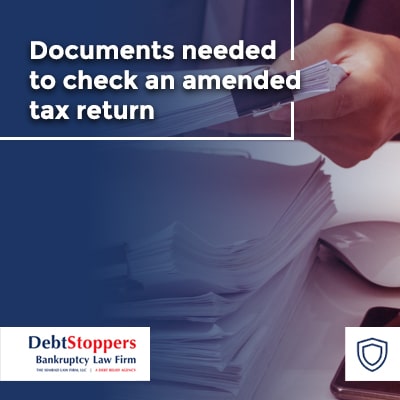Where's my amended tax return?
Updated on 16 May 2025

To check the status of your amended tax return, you can use the "Where's My Amended Return?" tool provided by the Internal Revenue Service (IRS). This online tool allows you to track the processing status of your amended tax return. To use the "Where's My Amended Return?" tool visit the IRS website at www.irs.gov and navigate to the "Where's My Amended Return?" tool. Then enter your information and check your amended return status.
Please note that it may take some time for the IRS to process amended tax returns, so it is essential to check the status periodically for updates. The "Where's My Amended Return?" tool is typically updated once every three weeks, so you may not see immediate changes after submitting your amended return.
What is an amended tax return?
An amended tax return is a form used to correct errors or make changes to a previously filed tax return. If you discover mistakes or omissions on your original tax return after it has been filed, you can use Form 1040-X to make corrections.
Common reasons why you might need to file an amended tax return include reporting errors, filing status changes, income changes, deduction or credit changes, dependent information, and tax calculation errors.

Documents needed to check an amended tax return
To file an amended tax return, you must complete and submit Form 1040-X along with any supporting documentation to the IRS. When completing Form 1040-X, you also need to provide information about the original tax return you're amending, the changes you're making, and the reasons for the changes. Additionally, you will need to provide basic information including:
-
Social security number
-
Date of birth
-
Zip code
How to file an amended tax return online?
Filing an amended tax return online can help correct errors on a previously submitted return. The IRS Form 1040-X, also known as the Amended U.S. Individual Income Tax Return, is used to report changes such as incorrect income, deductions, credits, or filing status.
Before submitting an amendment, confirm whether a correction is necessary. The IRS automatically corrects minor mistakes like math errors, but you need to file Form 1040-X for significant changes, such as missing income or incorrect deductions. The IRS now allows e-filing of amended returns for tax years 2020 and later. You can use online tax filing services or the IRS Free File system to complete and submit your amendment electronically.
Before amending your return, have your original tax return (Form 1040), supporting documents (W-2s, 1099s, receipts, etc.), and any IRS notices related to your tax filing. Then use an approved tax filing website to fill out Form 1040-X, specifying the changes you are making, and the reasons for amending.
Once your amended return is e-filed, you can check its status using the IRS “Where’s My Amended Return?” tool. Processing times for amended returns can take up to 16 weeks. If you need help correcting past returns, consulting a tax filing service or attorney can ensure the process goes smoothly and minimize potential penalties.
Returns you can’t check with an amended return
There are certain types of tax returns that you can't check using the "Where's My Amended Return?" tool provided by the IRS including:
-
Business Tax Returns - Amended returns for business entities, such as corporations, partnerships, and certain types of trusts and estates, cannot be checked using the online tool.
-
Amended Returns Filed by Mail - If you filed your amended return by mail, it may not be available for online tracking immediately. Amended returns filed by mail typically take longer to process compared to electronically filed returns, and there may be delays in updating the online system with the status of these returns.
-
Prior Year Amended Returns - The "Where's My Amended Return?" tool is designed to track the status of amended returns for the current tax year and up to three prior tax years.
-
Multiple Amended Returns - If you filed multiple amended returns for the same tax year, you may only be able to track the most recent amended return status using the online tool. The status of previous amended returns may not be available for online tracking.
-
Amended Returns in Certain Situations - In some cases, such as when the IRS initiates changes or corrections to your tax return, you may not be able to use the "Where's My Amended Return?" tool to track the status of those changes. The tool is primarily intended for taxpayer-initiated amended returns.
How do I know if I need to file an amended tax return?
Not every mistake on a tax return requires an amendment, so it's essential to determine if filing an amended tax return is necessary. The IRS automatically corrects minor errors, such as miscalculations, so you generally do not need to amend your return for simple math mistakes. However, you should file an amendment if you reported incorrect income from a W-2, 1099, or other sources to avoid underreporting penalties.
You should file an amendment if your filing status is incorrect, you missed deductions or credits, and/or claimed the wrong dependents.
Additionally, If the IRS identifies an issue with your tax filing, they may request that you submit an amendment. Ultimately, if you are unsure whether to file an amendment, a tax filing service or attorney can review your return and provide expert guidance. Taking action quickly can help you correct mistakes and avoid interest or penalties.

Why is my amended return taking so long?
There are several reasons why an amended tax return may take longer to process than a regular tax return. Some of the common factors that can contribute to delays in processing amended returns include:
-
Processing Timeframes - Amended tax returns generally take longer to process than original tax returns. The IRS typically processes amended returns manually, which can result in longer processing times compared to electronically filed original returns.
-
High Volume of Amended Returns - During peak tax seasons or when there are significant changes in tax laws, the IRS may experience a high volume of amended returns, leading to delays in processing.
-
Complexity of Changes - If your amended return involves complex changes or corrections, such as adjustments to multiple tax years, recalculations of tax liability, or additional documentation requirements, it may take longer to process the amendments.
-
Verification of Information - The IRS may need to verify the accuracy of the information provided on your amended return, particularly if there are discrepancies or inconsistencies with the original return.
-
Errors or Missing Information - If there are errors or missing information on your amended return, it may require additional time for the IRS to address and resolve these issues. Incorrectly completed forms, missing documentation, or incomplete information can lead to delays in processing.
-
Manual Review Process - Amended returns often undergo manual review by IRS personnel, which can result in longer processing times compared to automated processing of original returns. Manual review is necessary to ensure the accuracy and completeness of amended return information.
-
IRS Processing Backlogs - Periods of high volume or backlogs in IRS processing centers, such as during tax filing deadlines or when there are significant tax law changes, can result in delays in processing all types of tax returns, including amended returns.
Can you cancel an amended tax return?
Once you submit an amended tax return, it cannot be canceled or withdrawn. However, if you realize you made a mistake after filing Form 1040-X, there are a few steps you can take. If your amendment has not been processed yet, the IRS may allow you to submit a second amended return with the correct information.
If you find an error in your amended tax return, you can file a new Form 1040-X to correct the mistake. The latest submission will supersede the previous amendment.
If you made a serious error on your amended return, you can contact the IRS at 1-800-829-1040 to discuss your options. They may provide guidance on how to rectify the situation.
However, many people opt to work with a professional since filing multiple amendments can be complex and confusing. A tax filing service or tax attorney can help ensure your corrections are handled properly, preventing unnecessary IRS scrutiny.
While you cannot cancel an amended tax return, acting quickly to correct any issues can prevent delays and further complications with your tax filings. If you need assistance, reaching out to DebtStoppers can help you navigate the process with confidence.
What if I can’t find my amended tax return status?
If you're concerned about the status of your amended return or can’t find your amended tax status, you can contact the IRS directly at 1-866-464-2050 for assistance. Be prepared to provide your name, Social Security number, date of birth, zip code, and other relevant information when inquiring about the status of your amended return.
How to file an amended tax return
Filing an amended tax return involves submitting Form 1040-X, also known as the Amended U.S. Individual Income Tax Return, to the IRS. Here's a step-by-step guide on how to file an amended tax return:
-
Obtain a copy of Form 1040-X and the instructions from the IRS website or by contacting the IRS directly. You'll also need a copy of your original tax return that you're amending.
-
Fill out Form 1040-X accurately and completely. Provide your name, address, Social Security number, and filing status at the top of the form. Indicate the tax year you are amending and explain the reason(s) for the changes you are making.
-
In the "Explanation of Changes" section of Form 1040-X, enter the corrected figures for the items you're amending. This includes adjustments to income, deductions, credits, and tax liability.
-
Attach any necessary supporting documents to substantiate the changes you're making on Form 1040-X. This may include revised schedules, forms, or other documentation related to your amended return.
-
Sign and date Form 1040-X at the bottom of the first page. If you're filing a joint return, both spouses must sign and date the form. Incomplete or unsigned forms may be returned by the IRS for correction.
-
Once you've completed and signed Form 1040-X, mail it to the appropriate IRS mailing address. Make sure to include any supporting documents, and keep a copy of the amended return for your records.
-
You can check the status of your amended return using the "Where's My Amended Return?" tool on the IRS website. This tool provides updates on the processing status of your amended return and any associated refund.
-
If the IRS needs additional information or has questions about your amended return, they may send you correspondence requesting clarification or supporting documentation. Respond promptly to any IRS correspondence to avoid delays in processing.
If you discover errors or omissions on your original return, it's essential to file an amended tax return as soon as possible to avoid potential penalties or interest charges. Be thorough and accurate when completing Form 1040-X, and keep copies of all documentation for your records. If you need assistance or have questions about how to file an amended tax return, consider consulting a tax professional or contacting the IRS directly for guidance.
Can I amend a tax return from 5 years ago?
It depends. Generally, you have up to three years from the original due date of the tax return to file an amended return to claim a refund or make corrections. For example, if the original due date of the tax return was April 15, 2021, you have until April 15, 2024, to file an amended return for the 2021 tax year.
There is no time limit for filing an amended return to pay additional tax owed. If you discover errors or omissions that result in additional tax liability, you can file an amended return at any time to correct the errors and pay the additional tax owed.
The statute of limitations for claiming a refund is generally three years from the original due date of the tax return or two years from the date the tax was paid, whichever is later. Once the statute of limitations expires, you lose the opportunity to claim a refund for that tax year.
The following exceptions extend the time limit for claiming a refund beyond three-years
-
Taxpayers in a federally declared disaster area may have an extended deadline to amend their tax returns.
-
Taxpayers who have experienced certain financial hardships or disabilities may qualify for an extension of the refund claim deadline.
-
Taxpayers who filed their original tax return late may have an extended deadline based on the actual filing date.
State tax return amendment rules may vary from federal rules, so it's important to check with the applicable state tax agency for specific guidelines regarding amending state tax returns.
If you are wondering “Can I amend a tax return from 5 years ago or earlier?”, it's advisable to consult with a tax professional or contact the IRS directly to determine if you qualify for any exceptions to the three-year time limit for claiming a refund. They can provide guidance based on your specific circumstances and help you navigate the process of filing an amended return.




